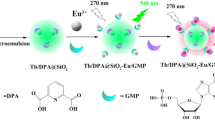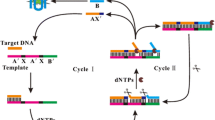Abstract
During the detection in complex biological system, similar to other fluorescence probes, the molecular beacons suffer severely from the background signal interference. Recent studies indicated that excimer molecular beacon (EMB) can address the problem. EMB is a dual-pyrene-labeled hairpin DNA structure with large Stokes shift and long fluorescence lifetime, which afford an effective strategy for detection in complex biological environment. In the chapter, the recent development of the research of EMB is presented. Firstly, the general design of EMB, as well as the structure and working mechanism, is introduced. Furthermore, the synthesis and properties of EMB are descripted, which explain its capability of detection in complex environment and high sensitivity and selectivity. Finally, the examples of the different applications are discussed, including nucleic acids and other molecules detection.
Access this chapter
Tax calculation will be finalised at checkout
Purchases are for personal use only
Similar content being viewed by others
References
Tyagi S, Kramer FR (1996) Molecular beacons: probes that fluoresce upon hybridization. Nat Biotechnol 14:303–308
Tyagi S, Bratu DP, Kramer FR (1998) Multicolor molecular beacons for allele discrimination. Nat Biotechnol 16:49–53
Tyagi S, Marras SAE, Kramer FR (2000) Wavelength-shifting molecular beacons. Nat Biotechnol 18:1191–1196
Zhang P, Beck T, Tan W (2001) Design of a molecular beacon DNA probe with two fluorophores. Angew Chem Int Ed 40:402–405
Wang K, Tang Z, Yang C et al (2009) Molecular engineering of DNA: molecular beacons. Angew Chem Int Ed 48:856–870
Dubertret B, Calame M, Libchaber AJ (2001) Single-mismatch detection using gold-quenched fluorescent oligonucleotides. Nat Biotechnol 19:365–370
Song S, Liang Z, Zhang J et al (2009) Gold-nanoparticle-based multicolor nanobeacons for sequence-specific DNA analysis. Angew Chem Int Ed 48:8670–8674
Jayagopal A, Halfpenny KC, Perez JW et al (2010) Hairpin DNA-functionalized gold colloids for the imaging of mRNA in live cells. J Am Chem Soc 132:9789–9796
Fujimoto K, Shimizu H, Inouye M (2004) Unambiguous detection of target DNAs by excimer-monomer switching molecular beacons. J Org Chem 69:3271–3275
Yamana K, Ohshita Y, Fukunaga Y et al (2008) Bis-pyrene-labeled molecular beacon: a monomer-excimer switching probe for the detection of DNA base alteration. Bioorg Med Chem 16:78–83
Conlon P, Yang C, Wu Y et al (2008) Pyrene excimer signaling molecular beacons for probing nucleic acids. J Am Chem Soc 130:336–342
Yamana K, Iwase R, Furutani S et al (1999) 2′-pyrene modified oligonucleotide provides a highly sensitive fluorescent probe of RNA. Nucleic Acids Res 27:2387–2392
Wilson JN, Kool ET (2006) Fluorescent DNA base replacements: reporters and sensors for biological systems. Org Biomol Chem 4:4265–4274
Paris PL, Langenhan JM, Kool ET (1998) Probing DNA sequences in solution with a monomer-excimer fluorescence color change. Nucleic Acids Res 26:3789–3793
Matray TJ, Kool ET (1999) A specific partner for abasic damage in DNA. Nature 399:704–708
Marti AA, Li X, Jockusch S et al (2006) Pyrene binary probes for unambiguous detection of mRNA using time-resolved fluorescence spectroscopy. Nucleic Acids Res 34:3161–3168
Huang J, Zhu Z, Bamrungsap S et al (2010) Competition-mediated pyrene-switching aptasensor: probing lysozyme in human serum with a monomer-excimer fluorescence switch. Anal Chem 82:10158–10163
Huang J, Wu Y, Chen Y et al (2011) Pyrene-excimer probes based on the hybridization chain reaction for the detection of nucleic acids in complex biological fluids. Angew Chem Int Ed 50:401–404
Yang C, Jockusch S, Vicens M et al (2005) Light-switching excimer probes for rapid protein monitoring in complex biological fluids. Proc Natl Acad Sci U S A 102:17278–17283
Wang C, Wu C, Chen Y et al (2011) Pyrene excimer for DNA sensors. Curr Org Chem 15:465–476
Häner R, Biner SM, Langenegger SM et al (2010) A highly sensitive, excimer-controlled molecular beacon. Angew Chem Int Ed 49:1227–1230
Nagatoishi S, Nojima T, Juskowiak B et al (2005) A pyrene-labeled G-quadruplex oligonucleotide as a fluorescent probe for potassium ion detection in biological applications. Angew Chem Int Ed 44:5067–5070
Zheng J, Li J, Gao X et al (2010) Modulating molecular level space proximity: a simple and efficient strategy to design structured DNA probes. Anal Chem 82:3914–3921
Zheng J, Li J, Jiang Y et al (2011) Design of aptamer-based sensing platform using triple-helix molecular switch. Anal Chem 83:6586–6592
Chen Y, Yang C, Wu Y et al (2008) Light-switching excimer beacon assays for ribonuclease H kinetic study. Chembiochem 9:355–359
Author information
Authors and Affiliations
Corresponding author
Editor information
Editors and Affiliations
Rights and permissions
Copyright information
© 2013 Springer-Verlag Berlin Heidelberg
About this chapter
Cite this chapter
Huang, J. (2013). Excimer Molecular Beacon. In: Yang, C., Tan, W. (eds) Molecular Beacons. Springer, Berlin, Heidelberg. https://doi.org/10.1007/978-3-642-39109-5_8
Download citation
DOI: https://doi.org/10.1007/978-3-642-39109-5_8
Published:
Publisher Name: Springer, Berlin, Heidelberg
Print ISBN: 978-3-642-39108-8
Online ISBN: 978-3-642-39109-5
eBook Packages: Chemistry and Materials ScienceChemistry and Material Science (R0)




